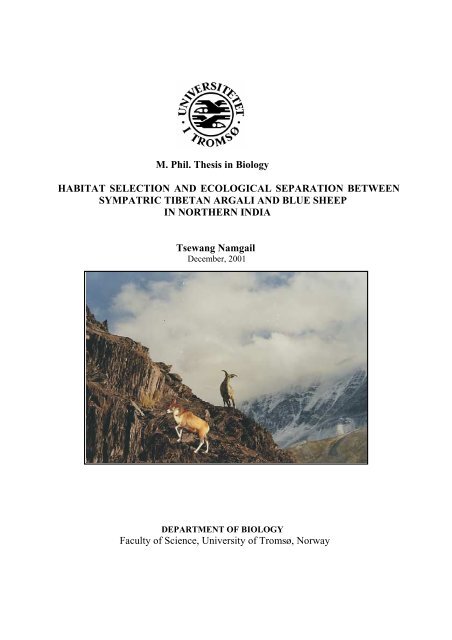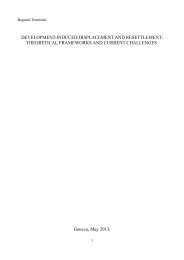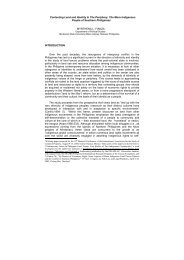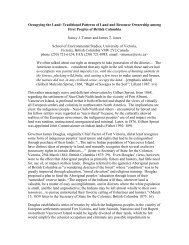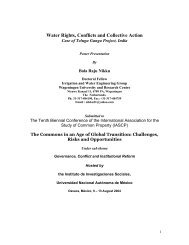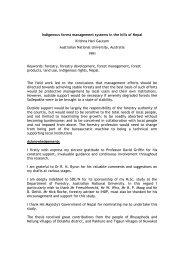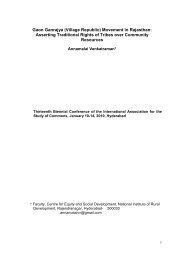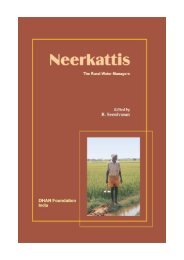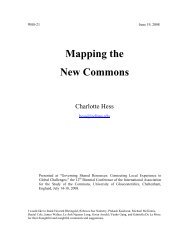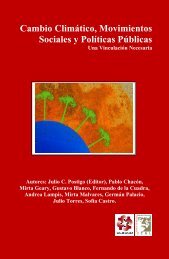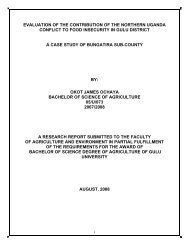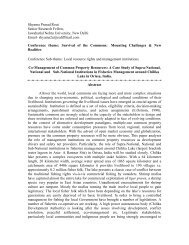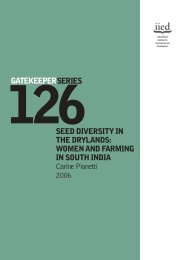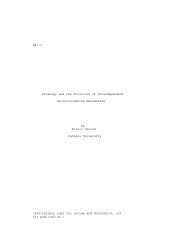M. Phil. Thesis in Biology HABITAT SELECTION AND ECOLOGICAL ...
M. Phil. Thesis in Biology HABITAT SELECTION AND ECOLOGICAL ...
M. Phil. Thesis in Biology HABITAT SELECTION AND ECOLOGICAL ...
- No tags were found...
Create successful ePaper yourself
Turn your PDF publications into a flip-book with our unique Google optimized e-Paper software.
M. <strong>Phil</strong>. <strong>Thesis</strong> <strong>in</strong> <strong>Biology</strong><strong>HABITAT</strong> <strong>SELECTION</strong> <strong>AND</strong> <strong>ECOLOGICAL</strong> SEPARATION BETWEENSYMPATRIC TIBETAN ARGALI <strong>AND</strong> BLUE SHEEPIN NORTHERN INDIATsewang NamgailDecember, 2001DEPARTMENT OF BIOLOGYFaculty of Science, University of Tromsø, Norway
ABSTRACTSummer habitat utilisation and ecological separation between the sympatric mounta<strong>in</strong> ungulatesTibetan argali Ovis ammon hodgsoni and blue sheep Pseudois nayaur <strong>in</strong> Hemis High AltitudeNational Park, Ladakh, India were studied to determ<strong>in</strong>e how the two species coexist. I<strong>in</strong>vestigated the hypothesis that ecological separation between the blue sheep and Tibetan argalioccurs on the basis of physical habitat selection. Such separation was tested for on the basis ofexpected difference between the species, as related to proximity to cliffs associated with thespecies-specific anti-predator behaviour. Tibetan argali selected habitats away from cliffs whileblue sheep selected habitats close to cliffs. Blue sheep also selected steep slopes whereas argaliselected gentle slopes. Slope angle was found to be more important than distance to cliff <strong>in</strong>shap<strong>in</strong>g the niche relationship. The two species did not differ <strong>in</strong> their use of habitats <strong>in</strong> terms ofelevation and vegetation cover. They however differed <strong>in</strong> their use of plant communities; bluesheep selected sub-shrub and grass communities whilst argali selected forb communities. The twospecies are ecologically separated on the basis of physical habitat (and perhaps food), andpresumably do not compete for common resources.Key words: argali, blue sheep, habitat selection, resource partition<strong>in</strong>g.INTRODUCTIONSympatric species with similar niches may compete for common resources and coexist either bygeographical partition<strong>in</strong>g or resource partition<strong>in</strong>g (Lack, 1971; Schoener, 1974 & 1986; Schaller,1977). Based on niche theory and its relation to habitat selection (Hutch<strong>in</strong>son, 1957; Orians &Wittenberger, 1991), similar species with expected similar niches should be allopatric or shouldshow behavioural characteristics that separate them spatially or temporally with<strong>in</strong> the same range.The “Competitive Exclusion Pr<strong>in</strong>ciple” advocates that compet<strong>in</strong>g species coexist <strong>in</strong> a stableenvironment as a result of resource partition<strong>in</strong>g; if there is no such partition<strong>in</strong>g, then onecompet<strong>in</strong>g species will elim<strong>in</strong>ate or exclude the other (Gause, 1934 & 1935; Hard<strong>in</strong>, 1960).Competition is considered to be a major selective force caus<strong>in</strong>g differential use of resources bycoexist<strong>in</strong>g species (MacArthur, 1972; Cody, 1975; Pianka, 1976; Roughgarden, 1983), althoughprocesses like predation or different responses of species to environmental gradients may alsolead to resource partition<strong>in</strong>g (Connell, 1975; Wiens, 1977; Strong, 1984; Brown, 1987; Schoener,
1974 & 1986; Putman, 1996). For example, sympatric species that are similar <strong>in</strong> body size alsocompete with each other to avoid predators, an <strong>in</strong>teraction known as ‘apparent competition’(Holt, 1977 & 1984) or competition for ‘enemy-free space’ (Jeffries & Lawton, 1984), andconsequently may adopt different escape tactics, often lead<strong>in</strong>g to habitat partition<strong>in</strong>g. Even <strong>in</strong>food limited conditions competition may be prevented by predation, which keeps the populationof the competitors below the level at which food resources become limit<strong>in</strong>g (Hairston, et al.,1960; Putman, 1996). Sometimes, predation and competition together can affect preycommunities <strong>in</strong> a multitude of ways that often <strong>in</strong>teract (Utida, 1953; Connell, 1975; Schoener,1986; Warner et al., 1983; Holt, 1989).The pattern of resource partition<strong>in</strong>g <strong>in</strong> ungulate communities is widely studied (Jarman,1971; Jarman & S<strong>in</strong>clair, 1979; Hanley & Hanley, 1982; Gordon & Illius, 1989; Fritz et al.,1996; Voeten & Pr<strong>in</strong>s, 1999; Forsyth, 2000), but the mechanisms which produce suchpartition<strong>in</strong>g rema<strong>in</strong> elusive. The observed pattern of resource partition<strong>in</strong>g or niche differentiation<strong>in</strong> ungulate communities could be attributed to both ecological forces (current competition and/orpredation) and evolutionary history (ghost of competition past) (see Connell, 1980). In coevolvedcommunities, the extant species may have competed <strong>in</strong> the past and evolved differentmorphological and/or behavioural characteristics, through evolutionary time, thus accomplish<strong>in</strong>gresource partition<strong>in</strong>g. But this cannot be proved, as we cannot go back <strong>in</strong> time to check whetherthe species ever competed or there were some <strong>in</strong>cidences of elim<strong>in</strong>ation of other species whichcompeted (Andrewartha & Birch, 1954; Begon et al., 1996). Alternatively, dur<strong>in</strong>g the course ofevolution, they may have responded <strong>in</strong>dependently though differently to various selective forces.But aga<strong>in</strong>, we cannot <strong>in</strong> retrospect determ<strong>in</strong>e the past processes and check whether theyresponded <strong>in</strong>dependently and differently to selective forces. Therefore, the observed pattern ofresource partition<strong>in</strong>g <strong>in</strong> ungulate communities can only be tested and <strong>in</strong>terpreted <strong>in</strong> terms ofcurrent ecological forces. It is, however, not easy to disentangle various ecological processes andmechanisms shap<strong>in</strong>g such communities. To ascerta<strong>in</strong> the effect of any dynamic, the naturalsystem must be disturbed away from equilibrium by either add<strong>in</strong>g or remov<strong>in</strong>g <strong>in</strong>dividuals, butsuch experimental studies are difficult, if not impossible, <strong>in</strong> ungulate communities due tomanagement considerations and time constra<strong>in</strong>ts (e.g., their long life-span). In any case,competitive structur<strong>in</strong>g implies that <strong>in</strong>ter-specific competition is or has been an important force <strong>in</strong>determ<strong>in</strong><strong>in</strong>g which species are present <strong>in</strong> a community as well as their relative abundance and
esource use patterns (Hutch<strong>in</strong>son, 1959; S<strong>in</strong>clair, 1985). If such communities exist it seemsreasonable that there should be a limit to the similarity of coexist<strong>in</strong>g species (Hutch<strong>in</strong>son, 1959).The Tibetan argali Ovis ammon hodgsoni (hereafter termed "argali") and the blue sheepPseudois nayaur are two wild sheep and sheep-like ∗ species, respectively, of the Bovidae,subfamily Capr<strong>in</strong>ae, and have almost completely overlapp<strong>in</strong>g distributions (see Shackleton,1997) that encompass ca. 2500,000 km 2 over the high Himalaya and the entire Tibetan Plateau.Such a sympatric distribution of related species with similar ecological requirements implies thatthey do not compete, and there is some degree of resource partition<strong>in</strong>g. This may beaccomplished on the basis of habitat and/or diet separation. Initial food habit studies of argaliand blue sheep on the Tibetan plateau (Harris and Miller 1995; Miller and Schaller, 1998;Schaller, 1998) have shown a considerable overlap <strong>in</strong> diet, suggest<strong>in</strong>g that they accomplish theresource partition<strong>in</strong>g primarily by habitat separation. Therefore, keep<strong>in</strong>g <strong>in</strong> view the nichecomplementarity i.e., species that occupy similar position along one dimension (e.g., food) tendto differ along another dimension (e.g., cover) (Brown, 1975; Schoener, 1986; Pianka, 1994;Begon et al., 1996), I studied the anti-predator habitat selection of the two species to see howsuch selection contributes to their coexistence. Various anecdotal reports on argali and blue sheephabitat utilisation suggest that although both species are denizens of mounta<strong>in</strong>ous areas, bluesheep prefer steep terra<strong>in</strong> near cliffs whereas argali prefer open and roll<strong>in</strong>g terra<strong>in</strong> away fromcliffs (Clark, 1964; Fox, et al., 1991a; Schaller, 1977 & 1998). The biological basis for thisdifference <strong>in</strong> habitat use is expla<strong>in</strong>ed <strong>in</strong> terms of contrast<strong>in</strong>g predator avoidance strategiesassociated with morphological differences between the two species (Geist, 1971 & 1987b;Schaller, 1998). Thus, the long slender legs of argali enhance its cursorial strategy of out-runn<strong>in</strong>gpredators on the open and roll<strong>in</strong>g terra<strong>in</strong> of its preferred habitat. In contrast, the relatively shortand muscular legs of the blue sheep support its agility <strong>in</strong> steep and rugged terra<strong>in</strong> (i.e., cliffs)where it retreats to avoid predators which are generally less agile <strong>in</strong> such habitat. Thus, based onthis difference, the blue sheep and argali are expected to show some differences <strong>in</strong> their use ofhabitat related to predator avoidance.∗ In structure and habits, Pseudois is <strong>in</strong>termediate to Capra and Ovis but is apparently more closely related to Capra.Schaller (1977) described blue sheep as "aberrant goats with sheep-like aff<strong>in</strong>ities." He noted that Pseudois resemblesCapra <strong>in</strong> hav<strong>in</strong>g a broad, flat tail with a bare central surface, large dewclaws, no <strong>in</strong>gu<strong>in</strong>al glands, no preorbitalglands, and usually no pedal glands.
Various studies (Cerri and Fraser, 1983; Holmes, 1984; Belovsky, 1978; Sih, 1980; Festa-Bianchet, 1988; Boyer et al., 1998) with their implications to “optimal forag<strong>in</strong>g theory” suggestthat an animal should forage <strong>in</strong> areas where its <strong>in</strong>take rate is highest and predation risk lowest.Thus, the blue sheep and argali are expected to use habitats with high forage availability and lowpredation risk. In the study area, because food resources are generally more abundant outside ofcliffs (escape terra<strong>in</strong>), blue sheep tend to move outside of such escape terra<strong>in</strong> for feed<strong>in</strong>g. Wegge(1979) <strong>in</strong> a study on blue sheep <strong>in</strong> Nepal, reported it feed<strong>in</strong>g <strong>in</strong> open habitats, and bedd<strong>in</strong>g <strong>in</strong>more rugged terra<strong>in</strong>. Blue sheep while <strong>in</strong> open habitats, however, needs to strike a balancebetween food acquisition and predator avoidance. Thus, although blue sheep and argali may usethe same type of open mounta<strong>in</strong>ous terra<strong>in</strong> for forag<strong>in</strong>g, there should be a dist<strong>in</strong>ct differencebetween the two species <strong>in</strong> terms of their proximity to cliffs related to the respective anti-predatorstrategies. This expected difference provides the basis for the present study, especially so becauseno studies have hitherto actually measured argali habitat use <strong>in</strong> relation to physical habitat. Infact, there is little documentation of the resource partition<strong>in</strong>g <strong>in</strong> ungulates on the basis of habitatseparation associated with predator avoidance (S<strong>in</strong>clair, 1985). Although more extensive study ofargali distribution and habitat selection are planned with<strong>in</strong> the scope of a co-operative research <strong>in</strong>the Indian Trans-Himalaya (Fox, pers. comm.), the present study provides an <strong>in</strong>itial look at argaliand blue sheep relationships <strong>in</strong> a unique site of argali occurence <strong>in</strong> the Indian Trans-Himalaya.The Tibetan argali is the only subspecies of Ovis ammon that is listed as endangered onAppendix I of the Convention on International Trade <strong>in</strong> Endangered Species of Wild Fauna andFlora (CITES), and is so listed by the U.S. Fish and Wildlife Service. It is also listed as athreatened species by the Government of India and is a fully protected (schedule 1) species underJammu & Kashmir Wildlife Protection Act of 1978. The most recent estimate suggests that thereare not more than 7,000 Tibetan argali throughout its range (Schaller, 1998). With<strong>in</strong> India thereare only approximately 200 argali rema<strong>in</strong><strong>in</strong>g, mostly <strong>in</strong> Ladakh and a few <strong>in</strong> Sikkim (Fox andJohns<strong>in</strong>gh, 1997). The blue sheep, <strong>in</strong> contrast, is the most common mounta<strong>in</strong> ungulate on theTibetan plateau and its peripheral areas, but s<strong>in</strong>ce it constitutes a major prey of the endangeredsnow leopard Uncia uncia (Oli et al., 1993; Jackson, 1996), its conservation is important wheresnow leopards are be<strong>in</strong>g protected.The small population (approx. 20 <strong>in</strong>dividuals) of argali with<strong>in</strong> the Hemis National Park <strong>in</strong>Ladakh, India presents an <strong>in</strong>terest<strong>in</strong>g case where a small group recently established itself <strong>in</strong> a new
area, and currently presents a focus for conservation of this endangered animal <strong>in</strong> India. The factthat these argali have not greatly <strong>in</strong>creased <strong>in</strong> number s<strong>in</strong>ce the arrival of 3 <strong>in</strong>dividuals <strong>in</strong> 1978(Fox et. al., 1991a and unpubl. data) begs the question as to why. Thus, rely<strong>in</strong>g on theoreticallybased expectations regard<strong>in</strong>g niche (<strong>in</strong> this case habitat) separation, I have <strong>in</strong>itiated an<strong>in</strong>vestigation of habitat use differences between this argali population and the blue sheep thatshare its range. Because an understand<strong>in</strong>g of this resource separation could have importantimplications for conservation efforts related to this and other argali populations, I also addressthese issues.Based on local knowledge and past studies (e.g., Fox et al., 1991b), I del<strong>in</strong>eated theknown range of the small argali population <strong>in</strong> Hemis NP, and used this as the study area. With<strong>in</strong>this area I conducted observations on both species to determ<strong>in</strong>e if there was <strong>in</strong>deed the type ofphysical habitat separation expected on the basis of their predator avoidance strategies. Thus,distance to cliffs was measured, along with other physical variables such as slope angle andelevation that may affect such separation. Although difference <strong>in</strong> diet was not addressed <strong>in</strong> thissummer season study, easily obta<strong>in</strong>able data on the related factors of plant community type andvegetation cover were also gathered to assess the differences <strong>in</strong> vegetation use that could berelated to the aforementioned habitat differentiation.In summary, if predation was important <strong>in</strong> shap<strong>in</strong>g their niche relationship, I expectedblue sheep to use steep habitats near the cliffs and argali to use moderate slopes away from cliffs.Thus, I hypothesised that ecological separation between argali and blue sheep exists on the basisof physical habitat (escape terra<strong>in</strong>). Such separation was tested for on the basis of expecteddifference <strong>in</strong> distance to cliff, with possible additional <strong>in</strong>fluences by slope angle and/or elevation.STUDY AREAThis study was carried out <strong>in</strong> the known argali range <strong>in</strong> the north-western part of Hemis NationalPark (34 o N, 77 o E) <strong>in</strong> the Ladakh prov<strong>in</strong>ce of Jammu & Kashmir state, India (Fig. 1). The argalirange was del<strong>in</strong>eated based on the knowledge of local people and previous observations by others(Fox et al., 1991b; Fox, unpubl. data). The entire argali range currently used encompasses ca. 10km 2 <strong>in</strong> the headwaters of the Sh<strong>in</strong>go and Rumbak streams, and is situated <strong>in</strong> the Zanskar rangenear the confluence of the Indus and Zanskar rivers. It lies at a distance of ca. 25 km southwest ofLeh, the ma<strong>in</strong> city of Ladakh. There is a pass, Ganda La (4900 m), <strong>in</strong> the centre of the study area,
which is used by locals throughout the year and by tourists <strong>in</strong> the summer. With<strong>in</strong> the small argaliarea, topography varies from steep, rocky slopes at higher elevations to gently roll<strong>in</strong>g hills atlower elevations. Elevation with<strong>in</strong> the area used by argali ranges from 4000-5500 m. HemisNational Park is situated <strong>in</strong> the ra<strong>in</strong> shadow of the great Himalaya, hence the climate ischaracterised by cold and arid, with low plant productivity that is largely conf<strong>in</strong>ed to the shortgrowth season <strong>in</strong> summer. Temperatures <strong>in</strong> summer (June-Aug.) range from 15-35 o C(Chundawat, 1992). Annual precipitation <strong>in</strong> the Indus valley at Leh is about 100 mm, <strong>in</strong>creas<strong>in</strong>gsomewhat south-westward and altitud<strong>in</strong>ally to 500-1,000 mm <strong>in</strong> valleys at the northern base ofthe Himalaya (Hartmann, 1983), and is probably about 500 mm <strong>in</strong> the study area.FloraVegetation is characterised by dry alp<strong>in</strong>e steppe with small shrub (ma<strong>in</strong>ly Caragana spp.,Artemisia spp. and Lonicera sp.), sub-shrub (ma<strong>in</strong>ly Aconogonum sp. and Stachys sp.), grass(ma<strong>in</strong>ly Poa spp., Elymus spp. and Festuca sp.), sedge (Carex spp. and Kobresia spp.) and forb(ma<strong>in</strong>ly Potentilla spp., Oxytropis spp., Astragalus spp., Thermopsis sp. Delph<strong>in</strong>ium sp.,Dracocephalum sp. and Saussurea spp.) communities present.FaunaBesides the blue sheep and argali, there are myriad small mammals <strong>in</strong>clud<strong>in</strong>g Himalayan marmotMarmota bobak, Tibetan woolly hare Lepus oiostolus, mouse hare Ochotona spp., stone martenMartes fo<strong>in</strong>a, Himalayan weasel Mustela sibrica and red fox Vulpes vulpes montana. The majoravian species are snowcock Tetraogallus tibetanus, chukar Alectoris chukar, choughPyrrhocorax graculus and golden eagle Aquila charysetos. The large mammalian predators<strong>in</strong>clude snow leopard Uncia uncia, wolf Canis lupus chanko, and wild dog Cuon alp<strong>in</strong>us. Theselast three prey on blue sheep and argali, while red fox is a threat only to their young lambs. Allthe above species, except wild dog, were observed <strong>in</strong> the area dur<strong>in</strong>g the study period.
RumchungZh<strong>in</strong>gchenLeh(15 km)5367 m5335 mStudy areaYurutseRumbak6123 mRoadTrailRidgel<strong>in</strong>esFig. 1. Study area <strong>in</strong> the Rumbak and Sh<strong>in</strong>go catchments of Hemis National Park,Ladakh, India.
METHODSData collection on habitat useThe study was conducted dur<strong>in</strong>g the months of July and August, 2000. Data were collected fromselected trails and along ridges, all with good vantage po<strong>in</strong>ts. Observations were conducted us<strong>in</strong>g8x40 b<strong>in</strong>oculars and a 15-45X spott<strong>in</strong>g scope. Records were made of species type, group size,sex, age, date and time. Individuals were considered to be solitary or belong to different groupswhen they stood 50 m away from another group. The locations of the blue sheep and argali wereplotted on 1:50,000 topographic sheets. Elevation, distance to cliff, slope angle, vegetation type(plant community), and plant cover at the animal locations were recorded. Elevation and slopeangle were determ<strong>in</strong>ed from the topo-map’s contour l<strong>in</strong>es, and calculated from the measureddistance between the nearest contour l<strong>in</strong>es, respectively. Distance to cliff was determ<strong>in</strong>ed bymeasur<strong>in</strong>g the distance between the animal location and the nearest cliff. The vegetation was firstclassified <strong>in</strong>to five communities based on the physiognomy and dom<strong>in</strong>ant species, and mappedon the topo-sheet (Fig. 7). Subsequently, the blue sheep and argali locations were classified as todifferent vegetation communities. Vegetation cover was estimated <strong>in</strong> the field, with percentagecover at the animal locations recorded.Observations were taken between 0600 and 2000 hrs, but most of the observations wereobta<strong>in</strong>ed from 0600 to 1200 hrs. S<strong>in</strong>ce there were only 20 argalis present <strong>in</strong> the area,pseudoreplication was <strong>in</strong>evitable. However, dependency was m<strong>in</strong>imised by mak<strong>in</strong>g only oneobservation on a group per day. Due to the high fluidity of group membership and movements <strong>in</strong>and out of the study area, it is difficult to demonstrate that the same groups of blue sheep sharedthe argali range throughout the summer. In any case, on average ca. 50 blue sheep were dailyobserved <strong>in</strong> the study area. This population is a part of the larger population <strong>in</strong> the whole ofRumbak catchment, thus its habitat selection should not be viewed as absolute, but relative with<strong>in</strong>the argali range.Available habitatAvailability of a habitat is the quantity of that habitat accessible to the population of animalsdur<strong>in</strong>g the study period (Manly et al., 1993). The animals were assumed to have equal access to
all the available habitats as they could move across the study area with<strong>in</strong> a day. For availability ofhabitat, a systematic sample of habitat characterestics was obta<strong>in</strong>ed from a 1:50,000 topo-map ofthe study area. For this purpose, a po<strong>in</strong>t grid was overlaid on the topo-map and the habitatvariables at the location of each po<strong>in</strong>t were recorded. Habitat characters (distance to cliff, slopeangle and elevation) at 366 po<strong>in</strong>ts were sampled. Elevation was determ<strong>in</strong>ed from the contourl<strong>in</strong>es and slope angle was calculated from the measured distance between the nearest contourl<strong>in</strong>es. The distance to cliff was determ<strong>in</strong>ed by measur<strong>in</strong>g the distance between the respectivepo<strong>in</strong>t and the edge of the nearest cliff. The cliffs, very steep slopes (>45 o ) on an area more than20 m diameter with vertical drops of more than 3 meters, were identified and mapped <strong>in</strong> the field.To assess the vegetation availability, a reconnaissance survey of vegetation wasconducted with<strong>in</strong> the study area dur<strong>in</strong>g the months of July and August, 2000. The plantidentification was carried out <strong>in</strong> the field us<strong>in</strong>g “Flowers of the Himalaya” (Polun<strong>in</strong> and Sta<strong>in</strong>ton,1985) as a reference, and by Dr. Henry Noltie from the Royal Botanic Garden, UK. For theavailability of vegetation, a systematic sample of vegetation communities at 366 po<strong>in</strong>ts wastaken, as described earlier.Data analysisHabitat utilizationHabitat use was characterised by resource selection functions (RSFs) that are proportional to theprobability of a resource be<strong>in</strong>g used by an animal. S<strong>in</strong>ce <strong>in</strong>dividual animals were not identifiedand were assumed to be randomly sampled, and available population proportion of habitatcharacterestics was assumed to be known, the habitat selection data conformed to Design 1 withsampl<strong>in</strong>g protocol A, accord<strong>in</strong>g to Manly et al. (1993) (see Appendix I). Although availabilitywas sampled, s<strong>in</strong>ce it was a systematic and <strong>in</strong>tensive sampl<strong>in</strong>g with a po<strong>in</strong>t grid overlaid on thesmall study area, I assume that the sample available proportion represents the populationproportion.Measur<strong>in</strong>g habitat preference has often been studied by relat<strong>in</strong>g use of a habitat to itsavailability (Neu et. al., 1974; Alldredge and Ratti, 1986 & 1992; Thomas and Taylor 1990;Manly et al., 1993). When resources are used disproportionately to their availability, use is saidto be selective (Manly et. al., 1993). Resource selection occurs <strong>in</strong> a hierarchical fashion from the
geographic range of a species, to <strong>in</strong>dividual home range with<strong>in</strong> a geographic range, to use ofgeneral features (habitats) with<strong>in</strong> the home range, to selection of particular elements (food items)with<strong>in</strong> the general features (or feed<strong>in</strong>g site) (Manly et al., 1993). In this study, habitat selection ofblue sheep and argali with<strong>in</strong> the assumed argali home range was <strong>in</strong>vestigated.For the determ<strong>in</strong>ation of resource selection, the variables were classified <strong>in</strong>to dist<strong>in</strong>ctcategories conta<strong>in</strong><strong>in</strong>g at least five observations each, with few exceptions. The distance to cliffwas categorised <strong>in</strong>to "very close to cliff" (450 m). Slope angle was categorised <strong>in</strong>to "flat" (50 o ). Elevation was categorised <strong>in</strong>to"low" (4900 m).Likewise, vegetation was categorised <strong>in</strong>to the follow<strong>in</strong>g communities: Shrub, Sub-shrub, Grass,Sedge and Forb. The selection ratio for each category was calculated asŵ i = o i / π i (eqn 1)where ŵ i is the selection ratio, o i is the proportion of used units <strong>in</strong> category i, and π i is theproportion of available resource units <strong>in</strong> category i. The standardised selection ratio B i was alsocalculated for each category to check for relative preference between categories. To statisticallytest significant departures of use from availability, the modified X 2 : log-likelihood chi-square test(X 2 L ) was calculated asIX L2= 2 ∑ u i log e {u i / u + π i )} (eqn 2)i=1where u i is the number of used resource units <strong>in</strong> category i, u + is the total number of used2resource units sampled and π i is the proportion of available resource units <strong>in</strong> category i. If the X Lwas significant, the null hypothesis: all habitats are used <strong>in</strong> proportion to their availability (noselection) was rejected. Subsequently, for each habitat category, the Bonferroni-adjusted 100(1-α) % confidence <strong>in</strong>tervals were constructed aso i ± Zα /2I √{o i (1-o i ) / u + } (eqn 3)
where o i is the proportion of used units <strong>in</strong> category i, u + is the total number of used resource unitssampled and I is the number of habitat categories. A habitat category was selected if the lowerconfidence <strong>in</strong>terval for that category was greater than the correspond<strong>in</strong>g population proportion.Similarly, a habitat category was avoided when the upper confidence <strong>in</strong>terval for that categoryexcluded the correspond<strong>in</strong>g population proportion.Ecological separationAlthough the chi-square analyses and the subsequent Bonferroni-adjusted confidence <strong>in</strong>tervalsshed light on the resource partition<strong>in</strong>g, a multivariate approach was used ma<strong>in</strong>ly to determ<strong>in</strong>e themost crucial variable that separated the two species. For this purpose, cont<strong>in</strong>uous variables wereused, and data were screened to check for the assumptions of normality and homogeneity ofvariance. All but blue sheep’s distance to cliff and argali’s elevation were close to normal. Theblue sheep’s distance to cliff was log-transformed to better approximate normality; however,transformation of argali’s elevation did not improve the normality as the variable had a bimodaldistribution.To check for differences <strong>in</strong> means of variables, namely slope angle, distance to cliff,elevation and vegetation cover for blue sheep and argali, the t-test for <strong>in</strong>dependent samples wasused—as this is less sensitive to the assumption of normality, especially when the sample size islarge (Manly, 1994). The multivariate Hotell<strong>in</strong>g’s T 2 test was used to check the differences <strong>in</strong>means tak<strong>in</strong>g all the variables together, thus tak<strong>in</strong>g proper account of the correlation betweenvariables (Manly, 1994).Those variables with significant mean differences were selected for further analysis ofresource partition<strong>in</strong>g. Independent L<strong>in</strong>ear Discrim<strong>in</strong>ant Analysis was used to determ<strong>in</strong>e whetheranimal locations could be discrim<strong>in</strong>ated on the basis of their environmental characteristics.Discrim<strong>in</strong>ant analysis is a multivariate statistical technique useful for <strong>in</strong>vestigat<strong>in</strong>g with<strong>in</strong> andbetween group variability, test<strong>in</strong>g differences <strong>in</strong> the composition of groups and identify<strong>in</strong>gvariables most useful <strong>in</strong> determ<strong>in</strong><strong>in</strong>g the most likely group membership of <strong>in</strong>dividual cases. Inthis study all locations of blue sheep comprised one group and all locations of argali the other.
RESULTSA total of 82 groups of blue sheep and 105 groups of argali were observed (Fig. 2) dur<strong>in</strong>g the twomonth study period. The argali population was composed of three adult males, eleven adultfemales, one yearl<strong>in</strong>g and five lambs. Most of the blue sheep observed consisted of all-malegroups.Habitat utilizationIn all the tables below, the available sample proportion represents the available populationproportion of the study area (see methods).Distance to cliffFor argali, the calculated chi-square test (X 2 L = 19.53, p < 0.01) was highly significant, thusreject<strong>in</strong>g the null hypothesis of no selection. The lower limit of the habitat category “away fromcliff” was greater than the population proportion, <strong>in</strong>dicat<strong>in</strong>g its selection (Table 1, Fig. 3).Likewise the upper limit of the category “very close to cliff” excluded the population proportion,<strong>in</strong>dicat<strong>in</strong>g its avoidance. Argali tended to avoid habitat “farther away” from cliff, while it tendedto select habitat “close to cliff” (Table 1). The argali’s probability of us<strong>in</strong>g habitat “away fromcliff” (B 3 = 0.390) was 3 times greater than the probability of us<strong>in</strong>g habitat “farther away” (B 4 =0.179).Table 1. Estimated selection <strong>in</strong>dices, relative probabilities and Bonferroni confidence <strong>in</strong>tervals for distance to cliffuse by argali.Distancecliff(meters)toVery close tocliff (450m)Available sample Use sample Selection Standardised Confidence <strong>in</strong>tervals<strong>in</strong>dex (ŵ i ) <strong>in</strong>dex (B i )Count Proportion Count ProportionLower Upper(m i ) (π i ) (u i ) (o i )41 0.119 6 0.058 0.490 - 0.141 0.002 0.114129 0.374 39 0.379 1.013 ns 0.291 0.264 0.494116 0.336 47 0.456 1.357 + 0.390 0.339 0.57359 0.171 11 0.107 0.624 ns 0.179 0.034 0.180Total 345 1.000 103 1.000 3.484 1.000Selection (+), avoidance (-) and non significant trends (ns)
CliffVillageTrailYurutseStudy areaFig. 2. Observations of the Tibetan argali and blue sheep along with locations of cliffs <strong>in</strong> the argali range<strong>in</strong> the Sh<strong>in</strong>go and Rumbak catchments.
60Percent use and available5040302010ns-+nsns+AvailableBlue sheepArgal<strong>in</strong>sns0450Distance to cliff (m)Fig. 3. Percent use and availability of distance to cliff for argali and blue sheep, <strong>in</strong>dicat<strong>in</strong>g selection (+), avoidance (-) and non-significance (ns) based on Bonferroni-adjusted 95% confidence <strong>in</strong>tervals.For blue sheep, the calculated X L 2 statistic (X L2= 9.7, p < 0.05) was significant,<strong>in</strong>dicat<strong>in</strong>g that at least one habitat category was selected. The habitat category “close to cliff” wasapparently selected significantly more often than is expected from the population proportion ofthis category (e.g., π 2 = 0.374 is below the lower limit of the confidence <strong>in</strong>terval 0.392-0.656)(Table 2, Fig. 3). In fact, the probability of habitat “close to cliff” be<strong>in</strong>g selected by blue sheepwas three times greater than that of the habitat “away from cliff ” (B 2 = 0.366, B 3 = 0.190). Bluesheep tended to select habitats very close to cliff, while it avoided areas “away” and “fartheraway” from cliff, though not significantly (Table 2, Fig. 3).Table 2. Estimated selection <strong>in</strong>dices, relative probabilities and Bonferroni confidence <strong>in</strong>tervals for distance to cliffuse by blue sheep.Distancecliff(Meters)toVery close tocliff (450m)Available sample Use sample Selection Standardised Confidence <strong>in</strong>tervals<strong>in</strong>dex (ŵ i ) <strong>in</strong>dex (B i )Count Proportion Count ProportionLower Upper(m i ) (π i ) (u i ) (o i )41 0.119 11 0.134 1.129 ns 0.295 0.044 0.244129 0.374 43 0.524 1.402 + 0.366 0.392 0.656116 0.336 20 0.244 0.725 ns 0.190 0.130 0.35859 0.171 8 0.098 0.570 ns 0.149 0.020 0.176Total 345 1.000 82 1.000 3.827 1.000Selection (+), avoidance (-) and non significant trends (ns)
Slope angleFor argali use of slope angle, the null hypothesis that all habitat categories are used <strong>in</strong> proportionto their availabilities was rejected thereby support<strong>in</strong>g the hypothesis that at least one habitatcategory was used disproportionately (X L 2 = 9.26, p < 0.05). The population proportion for the“moderate” slope (π 2 = 0.437) was below the lower limit of the 95% confidence <strong>in</strong>terval (0.496-0.724), which <strong>in</strong>dicates that this category is selected significantly (Table 3, Fig. 4). Argaliavoided “very steep” slopes. It also avoided “flat” and “steep” terra<strong>in</strong>, although not significantly(Table 3, Fig. 4). Nevertheless, the lower confidence limit of the category “flat” is negative,therefore needs to be <strong>in</strong>terpreted with some reservation. Argali’s probability of us<strong>in</strong>g moderateslopes (B 2 = 0.494) was twice more than that of us<strong>in</strong>g steep slopes (B 3 = 0.259).Table 3. Estimated selection <strong>in</strong>dices, relative probabilities and Bonferroni confidence <strong>in</strong>tervals for slope angle use byargali.Slope(degrees)angleAvailable sampleUse sampleSelection<strong>in</strong>dex (ŵ i )Standardised<strong>in</strong>dex (B i )Confidence <strong>in</strong>tervalsCount Proportion Count ProportionLower Upper(m i ) (π i ) (u i ) (o i )Flat (50) 10 0.027 0 0.000 0.000 - 0.000 _ _Total 366 1.000 105 1.000 2.821 1.000Selection (+), avoidance (-) and non significant trends (ns)† A negative value for the lower confidence limit for “Flat” was replaced with a 0 value s<strong>in</strong>ce a proportion can nottake a negative value.The alternative hypothesis of blue sheep select<strong>in</strong>g at least one slope category wassupported (X 2 L = 29.80, p < 0.01) significantly. The probability of select<strong>in</strong>g very steep terra<strong>in</strong> (B 4= 0.408) was 4 times greater than that of moderate terra<strong>in</strong> (B 2 = 0.187). The Bonferroni-adjusted95% confidence <strong>in</strong>tervals for the categories, “flat”, “steep” and “moderate” slopes excluded theirrespective population proportions, which <strong>in</strong>dicate that these habitat types are used non-randomly.The lower confidence limit for the habitat category “steep” slope excluded the availablepopulation proportion thus <strong>in</strong>dicat<strong>in</strong>g its selection; the upper confidence limits for “flat” and“moderate” terra<strong>in</strong> were lower than their respective population proportions thereby <strong>in</strong>dicat<strong>in</strong>g the
avoidance of these categories (Table 4, Fig. 4). Blue sheep tended to select very steep slopes.This however needs to be <strong>in</strong>terpreted with some reservation due to a negative lower limit.Table 4. Estimated selection <strong>in</strong>dices, relative probabilities and Bonferroni confidence <strong>in</strong>tervals for slope angle use byblue sheep.Slope(degrees)angleAvailable sample Use sample Selection Standardised Confidence <strong>in</strong>tervals<strong>in</strong>dex (ŵ i ) <strong>in</strong>dex (B i )Count Proportion Count ProportionLower Upper(m i ) (π i ) (u i ) (o i )Flat (50) 10 0.027 3 0.037 1.339 ns 0.408 0.000 † 0.087Total 366 1.000 82 1.000 3.285 1.000Selection (+), avoidance (-) and non significant trends (ns)† A negative value for the lower confidence limit for “very steep” slope was replaced with a 0 value s<strong>in</strong>ce aproportion can not take a negative value.80Percent use and available706050403020-++nsAvailableBlue sheepArgali100ns-ns50Slope angle (degrees)-Fig. 4. Percent use and availability of slope angle for argali and blue sheep, <strong>in</strong>dicat<strong>in</strong>g selection (+), avoidance (-)and non-significance (ns) based on Bonferroni-adjusted 95% confidence <strong>in</strong>tervals.Elevation
For argali use of elevation, test statistic was highly significant (X 2 L = 21.56, p < 0.01), thussupport<strong>in</strong>g the hypothesis that at least one habitat category is used non-randomly. The lower limitfor the very high elevation category excluded the population proportion, thus this habitat categorywas used more than expected (Table 5, Fig. 5). The probability of argali us<strong>in</strong>g “very high”elevations (B 4 = 0.471) was markedly higher than the probability of us<strong>in</strong>g other elevationcategories (B 1 = 0.142, B 2 = 0.165 and B 3 = 0.222). The same relationship holds between theunstandardised (ŵ i ) values. The upper limit for the middle elevation was lower than thepopulation proportion, thus show<strong>in</strong>g its avoidance. The confidence limit for low elevation isunreliable due to a negative lower limit.Table 5. Estimated selection <strong>in</strong>dices, relative probabilities and Bonferroni confidence <strong>in</strong>tervals for elevation use byargali.Elevation(meters)Low(4900)Available sample Use sample Selection Standardised Confidence <strong>in</strong>tervals<strong>in</strong>dex (ŵ i ) <strong>in</strong>dex (B i )Count Proportion Count ProportionLower Upper(m i ) (π i ) (u i ) (o i )26 0.075 4 0.038 0.508 ns 0.142 0.000 † 0.08384 0.242 15 0.143 0.590 - 0.165 0.061 0.225129 0.372 31 0.295 0.794 ns 0.222 0.188 0.402108 0.311 55 0.524 1.683 + 0.471 0.407 0.641Total 347 1.000 105 1.000 3.576 1.000Selection (+), avoidance (-) and non significant trends (ns)† A negative value for the lower confidence limit for “low” elevation was replaced with a 0 value s<strong>in</strong>ce a proportioncan not take a negative value.The calculated chi-square (X 2 L = 29.80, p < 0.01) for blue sheep use of elevation washighly significant, <strong>in</strong>dicat<strong>in</strong>g that proportion use of at least one habitat category was non-random(Table 6, Fig. 5). The standardised selection ratio for the use of “very high” elevation by bluesheep (B 4 = 0.484) was greater than the correspond<strong>in</strong>g ratio for “high” elevation (B 3 = 0.326),which reveals that the probability of us<strong>in</strong>g habitats at “very high” elevation is higher than that ofus<strong>in</strong>g habitats at “high” elevation. Blue sheep significantly avoided both low and middleelevations, whilst they tended to select high elevations. The lower confidence limit for the “veryhigh” elevation category was greater than the population proportion thus <strong>in</strong>dicat<strong>in</strong>g its selection(Table 6).
Table 6. Estimated selection <strong>in</strong>dices, relative probabilities and Bonferroni confidence <strong>in</strong>tervals for elevation use byblue sheep.Elevation(meters)Low(4900)Available sample Use sample Selection Standardised Confidence <strong>in</strong>tervals<strong>in</strong>dex (ŵ i ) <strong>in</strong>dex (B i )Count Proportion Count ProportionLower Upper(m i ) (π i ) (u i ) (o i )26 0.075 2 0.024 0.326 - 0.098 0.000 † 0.04684 0.242 6 0.073 0.302 - 0.091 0.004 0.142129 0.372 33 0.402 1.083 ns 0.326 0.273 0.531108 0.311 41 0.500 1.606 + 0.484 0.367 0.633Total 347 1.000 82 1.000 3.317 1.000Selection (+), avoidance (-) and non significant trends (ns)† A negative value for the lower confidence limit for “low” elevation was replaced with a 0 value s<strong>in</strong>ce a proportioncan not take a negative value.6050AvailableBlue sheepArgali++Percent use and available403020-nsns10--ns04900Elevation (m)Fig. 5. Percent use and availability of elevation for argali and blue sheep, <strong>in</strong>dicat<strong>in</strong>g selection(+), avoidance (-) and non-significance (ns) based on Bonferroni-adjusted 95% confidence<strong>in</strong>tervals.
VegetationThe X L 2 test statistic for argali’s selection of vegetation was highly significant (X L 2 = 189, p
Table 8. Estimated selection <strong>in</strong>dices, relative probabilities and Bonferroni confidence <strong>in</strong>tervals of vegetationcommunities used by blue sheep.VegetationcommunityAvailable sample Use sample Selection Standardised Confidence <strong>in</strong>tervals<strong>in</strong>dex (ŵ i ) <strong>in</strong>dex (B i )Count Proportion Count ProportionLower Upper(m i ) (π i ) (u i ) (o i )Shrub 140 0.383 18 0.220 0.574 - 0.078 0.099 0.341Sub-shrub 68 0.186 35 0.427 2.297 + 0.312 0.283 0.571Grass 28 0.077 17 0.207 2.710 + 0.367 0.089 0.325Sedge 14 0.038 4 0.049 1.275 ns 0.173 0.000 † 0.112Forb 26 0.071 1 0.012 0.172 - 0.023 0.000 † 0.044Barren 90 0.246 7 0.085 0.347 - 0.047 0.004 0.166Total366 1.000 82 1.000 7.375 1.000Selection (+), avoidance (-) and non significant trends (ns)† Negative values for the lower confidence limits for “Sedge” and “Forb” were replaced with 0 values s<strong>in</strong>ce aproportion can not take a negative value.6050+AvailableBlue sheepArgali+Percent use and available403020--ns+100-ns---Shrub Sub-shrub Grass Sedge Forb BarrenVegetation community-Fig. 6. Percent use and availability of vegetation communities for argali and blue sheep, <strong>in</strong>dicat<strong>in</strong>g selection (+),avoidance (-) and non-significance (ns) based on Bonferroni-adjusted 95% confidence <strong>in</strong>tervals.
Ecological separationThe slope angle used by blue sheep and argali differed significantly with regard to their means (t = -5.76, p < 0.001)(Table 9). Distance to cliff also showed significant difference (t = 2.68, p < 0.01) (Table 9). There was also evidenceof an overall difference between argali and blue sheep, tak<strong>in</strong>g all the variables viz., elevation, slope angle, distance tocliff and vegetation cover together (Hotell<strong>in</strong>g’s T 2 = 37.82, F (4, 182) = 9.3006, p < 0.001). The means for elevationand vegetation cover did not differ.Table 9. Comparison of mean values for argali and blue sheep with variables taken one at a time.VariableArgaliBlue sheepMean S.D. Mean S.D.t (185 d.f.)p-valueElevation 4837.43 235.58 4866.10 200.02 -0.88 0.379 nsSlope angle 31.00 7.19 36.77 6.25 -5.76 0.000***DistancecliffVegetationcoverto286.52 154.06 224.15 163.03 2.68 0.008**33.43 17.31 30.10 22.96 1.13 0.259 nsP < 0.001***, P < 0.01**, ns = non significantOnly those variables with significant mean differences were entered <strong>in</strong> the l<strong>in</strong>eardiscrim<strong>in</strong>ant function analysis. S<strong>in</strong>ce only two variables, namely slope angle and distance to cliffdiffered significantly with regard to their means and thus entered <strong>in</strong> the model, the locationsselected by argali and blue sheep were separated by only one discrim<strong>in</strong>ant function (Table 10).Slope angle was the more important variable for discrim<strong>in</strong>ation between the animal locations(Wilk’s lambda = 0.96, p < 0.001). Distance to cliff, however did not add much contribution tothe discrim<strong>in</strong>ation. Forty percent of the variability was expla<strong>in</strong>ed by differences between groups(x 2 = 31.92, p < 0.001).Table 10. Result of stepwise l<strong>in</strong>ear discrim<strong>in</strong>ant function analysis to test whether argali and blue sheep could beseparated based on different environmental characteristics.Function Eigen value % of var. Can. Cor. X 2 Standardised Can. Disc. Func.coefficients1 0.189 100 0.40 31.92 *** -0.92 (Slope angle)P < 0.001***0.24 (Distance to cliff)
ShrubSub-shrubGrassSedgeForbBarrenYurutseStudy areaFig. 7. Distribution of vegetation communities <strong>in</strong> the study area.
DISCUSSIONThe results of this study support the hypothesis that ecological separation between argali and bluesheep exists on the basis of physical habitat. Observations of the two species showed a dist<strong>in</strong>ctniche divergence, with argali us<strong>in</strong>g undulat<strong>in</strong>g terra<strong>in</strong> and blue sheep us<strong>in</strong>g more rugged terra<strong>in</strong>,which conforms to anecdotal reports (Fox et al., 1991a; Schaller, 1977 & 1998). This dist<strong>in</strong>ctdifference <strong>in</strong> the use of environmental features may be related to the species-specific antipredatorstrategies. Although the species also differed <strong>in</strong> their association with differentvegetation communities, it is difficult to conclude that they differ with regard to their diet.Nevertheless, habitat separation has been considered as the most common mode of resourcepartition<strong>in</strong>g <strong>in</strong> animals, followed by food (see Schoener, 1974). Much of the literature hasfocussed on competition as a plausible factor <strong>in</strong>fluenc<strong>in</strong>g such separations (Jenk<strong>in</strong>s and Wright,1988; Murray and Illius, 2000), while importance of predation <strong>in</strong> resource partition<strong>in</strong>g, althoughstudied extensively <strong>in</strong> other taxa (e.g., Mittelbach, 1984; Mercurio et al., 1985), is littleunderstood <strong>in</strong> ungulate communities. Predation may lead to habitat partition<strong>in</strong>g, provided thespecies are safest from predation <strong>in</strong> different habitats (Repasky, 1996). Dur<strong>in</strong>g the present study,carried out <strong>in</strong> the summer season when food competition is less likely, the two species partitionedhabitat <strong>in</strong> terms of variables deemed to be important <strong>in</strong> escap<strong>in</strong>g predators, imply<strong>in</strong>g that predatorrelated-mortality may be an important fitness component, plac<strong>in</strong>g a premium on predator escapeability. Hence, predation is a conceivable agent of selection responsible for the evolution ofhabitat partition<strong>in</strong>g.As expected, argali selected habitats “away from cliffs” and the blue sheep selectedhabitats “close to cliffs” (Tables 1 & 2, Fig. 3). The latter is consistent with the result obta<strong>in</strong>ed byChundawat (1992) <strong>in</strong> the whole of Rumbak catchment. Longva (1998), <strong>in</strong> a study of blue sheep’santi-predator habitat utilisation <strong>in</strong> the area, also found it us<strong>in</strong>g habitats significantly closer tocliffs than that available. Dur<strong>in</strong>g the present study, 65% of the sight<strong>in</strong>gs of blue sheep werewith<strong>in</strong> 250 m from cliffs (escape terra<strong>in</strong>). Such high aff<strong>in</strong>ity of blue sheep toward cliffs, whichgenerally support less vegetation, suggests that forage is not the only constra<strong>in</strong>t <strong>in</strong> their habitatuse. In contrast, over half of the argali’s observations were above 250 m from cliffs, whichillustrates the importance of open terra<strong>in</strong> <strong>in</strong> the determ<strong>in</strong>ation of habitat use by argali.Furthermore, blue sheep tended to select the habitat category “very close to cliff”, whilst argaliavoided this category (Fig. 3). Such differential habitat use by the two species, as related to
proximity to cliff implies little overlap on this dimension. However, adequate comparative dataneeds to be collected to determ<strong>in</strong>e the degree of overlap and possible competition.The lack of adequate habitat (ma<strong>in</strong>ly for argali) and vegetative diversity & productivity <strong>in</strong>the area is likely to <strong>in</strong>crease the possibility of an overlap <strong>in</strong> habitat and/or diet use, and thuscompetition between the two species. Such competition may however be averted by either spatialor temporal separation at the microhabitat level (Pianka, 1994), as demonstrated <strong>in</strong> severalmammalian sympatric species (e.g., Brown and Lieberman, 1973; M’Closkey and Fieldwick,1975; Dueser and Shugart 1978). Temporal separation was not addressed <strong>in</strong> this study, but somespatial separation was apparent <strong>in</strong> their use of microhabitat (Fig. 2). This segregation could bedue to a comb<strong>in</strong>ation of competition and predation, and consequently to the resource (food, coveretc.) partition<strong>in</strong>g by the two species. However, if competition was important <strong>in</strong> shap<strong>in</strong>g the nicherelationship, the blue sheep’s population should have decl<strong>in</strong>ed follow<strong>in</strong>g the argali’s arrival <strong>in</strong> thearea. But the formers population has shown a slight <strong>in</strong>crease dur<strong>in</strong>g the last decade (Fox, unpubl.data). Hence, predation may be the rather more important factor <strong>in</strong>fluenc<strong>in</strong>g this spatialseparation. Predatory risk provides an axis along which microhabitat partition<strong>in</strong>g can occur basedon trade-offs <strong>in</strong>volv<strong>in</strong>g predator avoidance and competitive abilities (Holt, 1989). Suchseparation may also occur as a result of the behavioural avoidance of one species by the other, apattern seen <strong>in</strong> other mounta<strong>in</strong> ungulates (e.g., Forsyth, 2000).Blue sheep’s selection of steep slopes, <strong>in</strong> contrast to argali’s selection of gentle slopes,reflects its agility and capability to negotiate steeper slopes. Blue sheep also tended to select“very steep” slopes, whereas argali completely avoided this category (Table 3 & 4), which furtherstrengthens the relationship. This notable difference <strong>in</strong> the use of slope, especially <strong>in</strong> such ruggedterra<strong>in</strong> affirms that they are ecologically separated, which may partly be attributed to themorphological differences associated with predator avoidance. This fundamental difference maypreclude or m<strong>in</strong>imise any competitive <strong>in</strong>teraction between the two species <strong>in</strong> this study area aswell as other areas where they come together. The tendency of blue sheep to select “very steep”slopes dur<strong>in</strong>g the present study is comparable to the result obta<strong>in</strong>ed by Chundawat (1992), whoreported blue sheep us<strong>in</strong>g very steep slopes (>40 o ) <strong>in</strong> proportion to its availability dur<strong>in</strong>gsummer, whilst it avoid<strong>in</strong>g such slopes dur<strong>in</strong>g all other seasons. Such a selection patternconforms to the contention that ungulates are more concerned about predators dur<strong>in</strong>g summerwhen the food is abundant.
Ecological separation may also be accomplished through altitud<strong>in</strong>al zonation of species(Green, 1987). Dur<strong>in</strong>g the present <strong>in</strong>vestigation, the <strong>in</strong>significant difference <strong>in</strong> means ofelevational use by the two species (Table 9), and therefore the considerable overlap <strong>in</strong> thealtitud<strong>in</strong>al distribution rules out such separation on an altitud<strong>in</strong>al gradient, thereby <strong>in</strong>creas<strong>in</strong>g thepossibility of a competitive <strong>in</strong>teraction. The f<strong>in</strong>e-gra<strong>in</strong>ed partition of habitat, as discussed earlier,may however reduce any such <strong>in</strong>teraction. The selection of high altitude by both argali and bluesheep (Table 5 & 6) may be attributed to the delayed phenology of plants at higher elevations(Johnston et al., 1968; Hoefs, 1979), and their attempt to take advantage of freshly sprout<strong>in</strong>gforage at such elevations dur<strong>in</strong>g summer. Both species are reported to use lower elevations <strong>in</strong> thearea dur<strong>in</strong>g w<strong>in</strong>ter (Mallon, 1991; Fox et al., 1991a). Seasonal migration over an altitud<strong>in</strong>algradient has been reported <strong>in</strong> other mounta<strong>in</strong> sheep, such as bighorn Ovis canadensis (see Geist,1971). In the case of blue sheep it might also be a strategy of reduc<strong>in</strong>g competition with thelactat<strong>in</strong>g females, as most of the observations of blue sheep at high elevations were male groups.To maximise their reproductive fitness, males that have bred females ought to vacate the areasused by these females while they are lactat<strong>in</strong>g (Geist and Petocz, 1977). The differential habitatuse by sexes as observed <strong>in</strong> other ungulate species (Festa-Bianchet, 1988; Forsyth, 2000),however could not be analysed <strong>in</strong> this study due to paucity of data on different sexes. The argali’shigh altitud<strong>in</strong>al distribution is also likely to be l<strong>in</strong>ked to disturbance by livestock. The female andnursery groups were seen at lower elevations dur<strong>in</strong>g the morn<strong>in</strong>g, and at higher elevations dur<strong>in</strong>gthe day when the herders tended the livestock at lower elevations. Such displacement of argali tohigher elevations by livestock has also been observed <strong>in</strong> the Mongolian Altai (Dzieciolowski etal., 1980). Nonetheless, further <strong>in</strong>vestigation needs to be carried out, possibly with anexperimental approach, to assess the effect of livestock graz<strong>in</strong>g on the argali’s habitat use on analtitud<strong>in</strong>al gradient, and as a consequence its (argali) <strong>in</strong>teraction with the blue sheep.There was no difference <strong>in</strong> the mean vegetation cover of the habitats selected by the twospecies (Table 9). Given the high aff<strong>in</strong>ity of blue sheep towards cliffs as an anti-predator strategy,and the heterogeneous distribution of forage <strong>in</strong> the area (i.e., more vegetation outside of cliffs,and the presumed positive relationship between distance to cliff and vegetation cover), one wouldexpect lower vegetation cover <strong>in</strong> habitats selected by the blue sheep than those selected by argali.But no such difference was observed. This may perta<strong>in</strong> to argali’s habitat shift <strong>in</strong> response to the
grow<strong>in</strong>g population of livestock, i.e., argali might have moved towards cliffs to avoid livestockrelated activities, thereby feed<strong>in</strong>g <strong>in</strong> habitats similar to those used by blue sheep.Sympatric ungulates tend to use different vegetation communities (Gordon, 1989).Therefore selection of vegetation communities was studied, but with an objective ofunderstand<strong>in</strong>g the differential habitat use; dietary partition<strong>in</strong>g is deferred to future studies.However, the vegetation community preferences observed dur<strong>in</strong>g the present <strong>in</strong>vestigation agreeto some extent with diet-based results of previous food habit studies on the Tibetan plateau(Schaller and Gu, 1994; Harris and Miller, 1995; Miller and Schaller, 1998), and Nepal Himalaya(Koirala and Shrestha, 1997). In assess<strong>in</strong>g my results, these need to be compared with somereservation because other results are based on diet analysis. Blue sheep <strong>in</strong> the present studyselected sub-shrub and grass communities (Table 8). This could be related to the preponderanceof these communities <strong>in</strong> vic<strong>in</strong>ity of the cliffs. Argali on the other hand predom<strong>in</strong>antly selectedforb communities (Table 7), which is consistent with the diet-based results obta<strong>in</strong>ed by Koirala &Shrestha (1997) and Miller and Schaller (1998). Both blue sheep and argali avoided shrubcommunities (dom<strong>in</strong>ated by Caragana sp. and Artemisia spp.).As per the nutritional relationships associated with <strong>in</strong>terspecific differences <strong>in</strong> body size(Bell, 1971; McNaughton and Georgiadis, 1986; Illius and Gordon, 1987; Mysterud, 1998;Gagon and Chew, 2000), one would expect blue sheep (relatively smaller) to show greateraff<strong>in</strong>ities for forb communities, and argali to demonstrate greater preference for grasscommunities. But, as discussed above, a converse relationship was observed dur<strong>in</strong>g this study.This could be ascribed to the preponderance of forbs <strong>in</strong> the argali’s realised niche determ<strong>in</strong>edma<strong>in</strong>ly by livestock graz<strong>in</strong>g <strong>in</strong> the area. Moreover, although blue sheep were found <strong>in</strong> the grassdom<strong>in</strong>atedcommunities, they may selectively feed on more nutritive species with<strong>in</strong> suchcommunities. In any case, the differential vegetation preference <strong>in</strong> this prelim<strong>in</strong>ary study suggestsm<strong>in</strong>imal overlap <strong>in</strong> diet. But diet analysis needs to be carried out to proclaim any dietaryseparation, and to ascerta<strong>in</strong> the significance of such separation <strong>in</strong> their coexistence.Despite the fact that argali use habitat away from cliff and blue sheep use habitat close tocliff, distance to cliff did not play a major role <strong>in</strong> discrim<strong>in</strong>at<strong>in</strong>g between the two species whenslope angle was <strong>in</strong>cluded <strong>in</strong> the discrim<strong>in</strong>ant function analysis (Table 10). It is however to benoted that both species tended to avoid the category “farther away” from cliff, <strong>in</strong>dicat<strong>in</strong>g that
they do not differ much <strong>in</strong> the use of habitat <strong>in</strong> terms of proximity to cliff, as they do <strong>in</strong> terms ofslope angle. This may well reflect the preponderance of cliffs <strong>in</strong> the area. In any case, it isobvious that slope angle is an important factor <strong>in</strong> argali’s choice of habitat, and <strong>in</strong> determ<strong>in</strong><strong>in</strong>g itscoexistence with blue sheep. Distance to cliff may also be an important factor, but it seems likethat the argali does not have much choice <strong>in</strong> this particular study area. Nonetheless, as alluded toearlier, the lack of argali’s selection of areas far from cliffs may also be attributed to the <strong>in</strong>fluenceof livestock on the argali’s choice of habitat. The daily herd<strong>in</strong>g of livestock <strong>in</strong> the area maydisplace argali from their preferred sites and push them towards the cliffs, which may <strong>in</strong> turn<strong>in</strong>crease the overlap <strong>in</strong> habitat use by the two wild ungulates. On an average, three herds, eachcompris<strong>in</strong>g of ca. 200 sheep and goats, graze <strong>in</strong> the area on a daily basis dur<strong>in</strong>g the short summer(pers. obs.). The argali’s preference for open and roll<strong>in</strong>g slopes makes them more vulnerable tolivestock associated disturbances, ma<strong>in</strong>ly due to the shepherds bias towards herd<strong>in</strong>g on moreopen slopes (Fox et al., 1994; Koirala and Shrestha, 1997; Herders, pers. comm.). The <strong>in</strong>fluenceof livestock on argali’s population dynamics has been envisaged elsewhere (Fedosenko, 1985;Fedosenko et al., 1995).Blue sheep on the other hand is less likely to be affected by the tended livestock becauseof their association with the cliffs. Longva (1998) found no considerable effect of livestockherd<strong>in</strong>g on blue sheep’s habitat use, i.e., blue sheep used the same slopes irrespective of livestockpresence. However, the displacement of argali from its preferred habitats, as discussed above,may <strong>in</strong>crease the likelihood of its competition with the blue sheep, thereby affect<strong>in</strong>g the lattershabitat use pattern. Thus the livestock may also affect the blue sheep population <strong>in</strong>directly.Dur<strong>in</strong>g the present study, the argali was observed keep<strong>in</strong>g a distance from the sheep and goats,perhaps as a response to the presence of the herder. In contrast, it was observed feed<strong>in</strong>g or rest<strong>in</strong>gvery close to cattle such as dzos (hybrid of yak and cow), which are free rang<strong>in</strong>g at least for thefew summer months. Harris and Miller (1995) also found argali feed<strong>in</strong>g <strong>in</strong> close proximity towild yaks, on the Tibetan plateau, without any agonistic behaviour. Thus only the tendedlivestock, ma<strong>in</strong>ly sheep and goats, might displace argali from their preferred habitats, i.e., pushargali towards the cliffs where the vegetation may be less and <strong>in</strong>teraction with the blue sheepmore. In other words, livestock posses the potential not only to compete for forage with argali,but also to exclude them from the desired sites due to their mere presence or the presence ofassociated herders and sometimes dogs.
Because of these circumstances associated with livestock disturbance, the argali may fallprey to both snow leopard (which stalks from the edge of terra<strong>in</strong> breaks such as cliffs) and wolf(which hunts <strong>in</strong> the open). The slow growth of the argali population <strong>in</strong> the area may be areflection of this situation. Two snow leopards were encountered <strong>in</strong> the area, and a pack of threewolves was also observed travers<strong>in</strong>g the argali home range frequently dur<strong>in</strong>g the present study.For blue sheep even the small cliffs may serve as refuge aga<strong>in</strong>st predators, especially wolf, thusreduc<strong>in</strong>g its depredation rate. Harris and Miller (1995) noticed blue sheep us<strong>in</strong>g boulder and screeof slate talus <strong>in</strong> Yeniugou, on the Tibetan plateau where availability of cliffs is low. Thus bluesheep may have a slight edge over argali <strong>in</strong> escap<strong>in</strong>g predators <strong>in</strong> this area. Argali <strong>in</strong> this studyarea may be both resource and predator limited, and such questions should be addressed <strong>in</strong>further detail.Another anthropogenic effect on argali’s habitat use is the heavy tourist traffic <strong>in</strong> this areadur<strong>in</strong>g the summer months. The argali range lies on the popular Markha trek route. This makesargali prone to tourism related developments. Argali have been seen runn<strong>in</strong>g uphill whendisturbed by the trekkers. This may leave argali with less energy for other vital activitiesimportant for its growth, reproduction and survivability. Moreover, the ponies used by thetrekk<strong>in</strong>g groups for transport<strong>in</strong>g their gear also graze <strong>in</strong> the area dur<strong>in</strong>g the night, when the lattercamp, which may further <strong>in</strong>crease the graz<strong>in</strong>g pressure.Potential for competition between argali and blue sheepThe strong aff<strong>in</strong>ity of blue sheep toward cliffs is likely to reduce both <strong>in</strong>terference andexploitation competition with argali, and may contribute to their coexistence. However, moreextensive studies with sufficient comparative data from all seasons need to be carried out tounderstand the <strong>in</strong>teraction properly. Although competition aspects on the food dimension was notaddressed <strong>in</strong> this study, argali's selection of forb community, and blue sheep's selection of subshruband grass communities suggest a m<strong>in</strong>imal overlap <strong>in</strong> diet, and presumably a reducedpossibility of competition <strong>in</strong> the dietary realm. Furthermore, s<strong>in</strong>ce there is a spatial separation atthe microhabitat level, and food is not likely to be limit<strong>in</strong>g dur<strong>in</strong>g the summer (Schaller and Gu,1994; Miller and Schaller, 1998), there is little prospect for competition (both exploitation and
<strong>in</strong>terference) between the two species dur<strong>in</strong>g this season. Their zone of sympatry, and overlap <strong>in</strong>resource use however are likely to <strong>in</strong>crease, should populations expand or availability of habitatdecl<strong>in</strong>e, thereby enhanc<strong>in</strong>g the potential for both food and habitat competition between them. An<strong>in</strong>crease <strong>in</strong> blue sheep's population may also <strong>in</strong>crease the possibility of an apparent competition(Holt, 1977) between the two species. Just as consumer species can reciprocally reduce eachothers abundance via deplet<strong>in</strong>g a shared resource, prey species can sometimes <strong>in</strong>directly depresseach other by <strong>in</strong>creas<strong>in</strong>g the abundance of a shared enemy (Holt, 1977; Holt & Lawton, 1993).Thus, <strong>in</strong>crease <strong>in</strong> blue sheep’s population may elicit a numerical response from the predators <strong>in</strong>the area, which may <strong>in</strong> turn decrease the argali’s population. This phenomenon and the limit<strong>in</strong>genvironment for argali <strong>in</strong> the area could work <strong>in</strong> tandem to keep its population low.Management implicationsThe resource selection pattern observed dur<strong>in</strong>g the present study may be useful <strong>in</strong> predict<strong>in</strong>gforag<strong>in</strong>g areas and habitat distribution of blue sheep and argali. Such pattern may also offeradditional <strong>in</strong>sight <strong>in</strong>to their ecology and habitat requirements. The <strong>in</strong>creased preference ofmoderate slopes by argali suggests that such terra<strong>in</strong> types must be managed for the long-termpersistence of this species. Despite the lack of vegetative diversity and productivity, HemisNational Park provides a mosaic of habitats with unique aggregation of rare and endangered wildanimal species. It is certa<strong>in</strong>ly one of the prime habitats for blue sheep (Fox and Nurbu, 1990).However, the slow growth of the small argali population raises the question of suitability of thispark for argali conservation. The Rumbak catchment of the park where argali is located is ruggedand precipitous, and has limited open area preferred by argali. Furthermore, a road to Rumbakvillage is currently under construction, the completion of which may facilitate a greater <strong>in</strong>flux oftourists to the area thereby pos<strong>in</strong>g more threat to the cont<strong>in</strong>ued survival of the aforementionedpopulation of argali. Thus, Hemis NP may not be the best place for future argali conservation,and attention may better be diverted to other areas such as the proposed Gya-Meeru wildlifesanctuary when it comes to manag<strong>in</strong>g and conserv<strong>in</strong>g this argali subspecies <strong>in</strong> India.The livestock number <strong>in</strong> Hemis National Park has shown a slight <strong>in</strong>crease dur<strong>in</strong>g the pastdecade (Bhatnagar et al., 1999). Therefore, the question of its compatibility with wildlifeconservation <strong>in</strong> the area needs to be addressed. On an average, three herds of domestic sheep and
goats graze daily <strong>in</strong> the argali range dur<strong>in</strong>g the short summer (June-August), as discussed earlier.Approximately one third of the population of livestock that graze <strong>in</strong> the area dur<strong>in</strong>g this seasonbelong to villages outside the boundary of Hemis NP. Of these, the non-lactat<strong>in</strong>g cattle such asdzos are free rang<strong>in</strong>g while the sheep and goats are herded by the park residents on lease, formanure. This may lead to an overstock<strong>in</strong>g, which may expedite the resource depletion andexclusion of the wild ungulates from the area. The excessive graz<strong>in</strong>g by livestock dur<strong>in</strong>g summermay also limit forage availability dur<strong>in</strong>g w<strong>in</strong>ter for the wild ungulates, especially argali, as it doesnot have enough suitable habitat to move around. Furthermore, on average five ponies used bytrekk<strong>in</strong>g groups to transport their gear, graze <strong>in</strong> this area each day through the short summer.Likewise, graz<strong>in</strong>g by small herbivores such as marmot and Tibetan woolly hare may further<strong>in</strong>crease the graz<strong>in</strong>g pressure. In summary, given the limited habitat, and the present amount ofdisturbance and graz<strong>in</strong>g pressure <strong>in</strong> the area, long term persistence of the small population ofargali is highly uncerta<strong>in</strong>.ACKNOWLEDGEMENTSI wish to express profound gratitude to my supervisor, Dr. Joseph L. Fox for his zealous <strong>in</strong>terest,constructive criticism and expert guidance throughout the study. I am greatly <strong>in</strong>debted to him forgiv<strong>in</strong>g me the opportunity to study the animals that lived <strong>in</strong> the mounta<strong>in</strong>s next to my home yet Iwas oblivious to them. I also express my s<strong>in</strong>cere gratitude to Dr. Yash Veer Bhatnagar, WildlifeInstitute of India, for his guidance and constant encouragement both <strong>in</strong> the field and through thewrit<strong>in</strong>g process.I should like to thank Dr. Henry Noltie, Royal Botanic Garden, UK, for his help <strong>in</strong> theidentification of plant specimens. Statistical advice of Dr. Rolf Anker Ims, is thankfullyacknowledged. I am also thankful to Mr. Abdul Rauf Zargar, Wildlife Warden, Department ofWildlife Protection, Leh, for grant<strong>in</strong>g permission to work <strong>in</strong> the Hemis National Park. I wish toexpress my gratitude to Anne Høydal, Adm<strong>in</strong>istrative Head, and all other staff at the Departmentof <strong>Biology</strong> who helped me <strong>in</strong> one way or the other. My gratitude is also due to all the fellowstudents at the said Department, especially Kishor, Bård and Rolf for their help andencouragement throughout the study.
Heartfelt thanks go to the Department of <strong>Biology</strong>, University of Tromsø for f<strong>in</strong>ancialsupport and necessary equipment for the fieldwork. The additional f<strong>in</strong>ancial support for fieldworkfrom the Center for Environment and Development, University of Tromsø, Statens Lånekasseand Earthwatch Institute, USA are equally acknowledged.I owe a special thanks to Paul, Rigmor, Odd and El<strong>in</strong>or for their k<strong>in</strong>d hospitality, and forprovid<strong>in</strong>g me a home away from home.Last but not the least, I am grateful to all the members of my family for their moralsupport. I am also thankful to the Snow Leopard Trails, and its entire staff for their help,especially Mr. Sonam Morup for his two months company <strong>in</strong> the field. The fieldwork was spicedup by the sight of two snow leopards, an animal that I always considered as elusive as theHimalayan Yeti and the North American Sasquatch.LITERATURE CITEDAlldredge, J.R. and J.T. Ratti, 1986. Comparison of some statistical techniques for analysis ofresource selection. J. Wildl. Manage. 50, 157-165Alldredge, J.R. and J.T. Ratti, 1992. Further comparison of some statistical techniques foranalysis of resource selection. J. Wildl. Manage. 56, 1-9Andrewartha, H.G. and L.C. Birch, 1954. Distribution and Abundance of Animals. University ofChicago Press, ChicagoBegon, M., J.L. Harper and C.R. Townsend, 1996. Ecology: Individuals, Populations andCommunities, pp. 945, Blackwell Scientific Publications, OxfordBell, R.H.V., 1971. A graz<strong>in</strong>g ecosystem <strong>in</strong> the Serengeti. Sci. Amer. 255, 86-93Belovsky, G.E., 1978. Diet optimisation <strong>in</strong> a generalist herbivore: the moose. Theor. Popul. Biol.14, 105-134Bhatnagar, Y., R. Wangchuk and R. Jackson, 1999. A survey of depredation and related wildlifehumanconflicts <strong>in</strong> Hemis National Park, Ladakh, Jammu & Kashmir, India. InternationalSnow Leopard Trust, SeattleBoyer, R.T., G.K. John and V.V. Ballenberghe, 1998. Habitat selection by neonatal black-taileddeer: climate, forage, or risk of predation? J. Mammal. 79, 415-425Brown, J.H., 1975. Geographical Ecology of Desert Rodents. In: Cody, M.L. and J.M. Diamond(eds) Ecology and Evolution of Communities, pp. 315-341, Belknap, Cambridge
Brown, J.H., 1987. Variation of desert rodent guilds: patterns, processes, and scales. In: GeeJ.H.R. and P.S. Giller (eds) Organisation of Communities: Past and Present. BlackwellScientific Publications, OxfordBrown, J.H. and G.A. Lieberman, 1973. Resource utilisation and coexistence of seed-eat<strong>in</strong>gdesert rodents <strong>in</strong> sand dune habitats. Ecology, 54, 788-797Cerri, R.D. and D.F. Fraser, 1983. Predation and risk <strong>in</strong> forag<strong>in</strong>g m<strong>in</strong>nows: balanc<strong>in</strong>g conflict<strong>in</strong>gdemands. Am. Nat. 121, 552-561Chundawat, R.S., 1992. The ecological studies of snow leopard and its associated prey species <strong>in</strong>Hemis National Park, Ladakh, India. PhD thesis, University of RajasthanClark, J.L., 1964. The great arc of the wild sheep, pp. 247, University of Oklahoma Press,NormanCody, M.L., 1968. On the methods of resource division <strong>in</strong> grassland bird communities. Am. Nat.102, 107-148Cody, M.L., 1975. Towards a theory of cont<strong>in</strong>ental species diversities. In: Cody, M.L. and J.M.Diamond (eds) Ecology and Evolution of Communities, pp. 214-257, Belknap, CambridgeConnell, J.H., 1975. Some mechanisms produc<strong>in</strong>g structure <strong>in</strong> natural communities. In: Cody,M.L. and J.M. Diamond (eds) Ecology and Evolution of Communities, pp. 460-490,Belknap, CambridgeConnell, J.H., 1980. Diversity and the co-evolution of competitors, or ghost of competition past.Oikos, 35, 131-138Connell, J.H., 1983. On the prevalence and relative importance of <strong>in</strong>terspecific competition:evidence from field experiments. Am. Nat. 122, 661-696Dueser, R.D. and H.H. Shugart, Jr., 1978. Microhabitats <strong>in</strong> forest-floor small mammal fauna.Ecology, 59, 89-98Dzieciolowski, R., J. Krupka, Bajandelder and R. Dziedzic, 1980. Argali and ibex populations <strong>in</strong>the Kuhsyrh Reserve <strong>in</strong> Mongolian Altai. Acta. Theriol. 25, 213-219Fedosenko, A.K., 1985. Present status of argali sheep populations <strong>in</strong> U.S.S.R. In: Hoefs, M. (ed)Wild sheep: distribution, abundance, management and conservation of the sheep of theworld and closely related mounta<strong>in</strong> ungulates, pp. 200-210, Northern Wild sheep andgoat council, Yukon Wildlife Branch, Whitehorse, Canada
Fedosenko, A.K., P.I. We<strong>in</strong>berg and R. Valdez, 1995. Argali sheep survey <strong>in</strong> the headwaters ofthe Korunduk River, Kirghizstan. Mammalia, 59, 452-455Festa-Bianchet, M., 1988. Seasonal range selection <strong>in</strong> bighorn sheep: conflicts between foragequality, forage quantity, and predator avoidance. Oecologia (Berl.), 75, 580-586Forsyth, D.M., 2000. Habitat selection and coexistence of the Alp<strong>in</strong>e chamois (Rupicaprarupicapra) and Himalayan tahr (Hemitragus jemlahicus) <strong>in</strong> the eastern Southern Alps,New Zealand. J. Zool., Lond. 252, 215-225Fox, J.L. and A.J.T. Johns<strong>in</strong>gh, 1997. Country report for India. In: Shackleton, D.M. (ed) Wildsheep and goats and their relatives, pp. 215-231, IUCN, Gland, Switzerland andCambridge, UKFox, J.L. and C. Nurbu, 1990. Hemis, a national park for snow leopard <strong>in</strong> India’s Trans-Himalaya. Int. Ped. Book of snow leopards, 6, 71-84Fox, J.L., C. Nurbu and R.S. Chundawat, 1991a. Tibetan argali (Ovis ammon hodgsoni) establisha new population. Mammalia, 55, 448-451Fox, J.L., C. Nurbu and R.S. Chundawat, 1991b. Mounta<strong>in</strong> ungulates of Ladakh, India. Biol.Conserv. 58, 167-190Fox, J.L., C. Nurbu, S. Bhatt and A. Chandola, 1994. Wildlife conservation and land-use changes<strong>in</strong> the Trans-Himalayan region of Ladakh, India. Mount. Res. Devel. 14, 39-60Fritz, H., M. de Gar<strong>in</strong>e-Wichatitsky & G. Letessier, 1996. Habitat use by sympatric wild anddomestic herbivores <strong>in</strong> an African savanna woodland: the <strong>in</strong>fluence of cattle spatialbehaviour. J. Appl. Ecol. 33, 589-598Gagon, M. and A.E. Chew, 2000. Dietary preferences <strong>in</strong> extant African Bovidae. J. Mammal. 81,490-511Gause, G.F., 1934. The struggle for existence. Baltimore:Williams & Wilk<strong>in</strong>s.Gause, G.F., 1935. Experimental demonstration of Volterra's periodic oscillation <strong>in</strong> the numbersof animals. Journal of Experimental <strong>Biology</strong>, 12, 44-48Geist, V., 1971. Mounta<strong>in</strong> sheep: A study of behaviour and Evolution, pp. 383, University ofChicago Press, ChicagoGeist, V., 1987b. On the evolution of the Capr<strong>in</strong>ae. In: Soma, H. (ed) The biology andmanagement of Capricornis and related mounta<strong>in</strong> antelopes, pp. 3-40, Croom Helm,London
Geist, V. and R.G. Petocz, 1977. Bighorn sheep <strong>in</strong> w<strong>in</strong>ter: do rams maximise reproductive fitnessby spatial and habitat segregation from ewes? Can. J. Zool. 55, 1802-1810Gordon, I.J., 1989. Vegetation community selection by ungulates on the Isle of Rhum. J. Appl.Ecol. 26, 65-79Gordon, I.J. and A.W. Illius, 1989. Resource partition<strong>in</strong>g by ungulates on the Isle of Rhum.Oecologia (Berl.), 98, 167-175Green, M.J.B., 1987. Ecological separation <strong>in</strong> Himalayan ungulates. J. Zool., Lond. 1, 693-719Hairston, N.G., F.E. Smith and L.B. Slobodk<strong>in</strong>, 1960. Community structure, population controland competition. Am. Nat. 94, 421-425Hanley, T.A. and K.A. Hanley, 1982. Food resource partition<strong>in</strong>g by sympatric ungulates on GreatBas<strong>in</strong> rangeland. Journal of Range Management, 35, 152-158Hard<strong>in</strong>, G., 1960. The competitive exclusion pr<strong>in</strong>ciple. Science, 131, 1292-1297Harris, R.B. and J.D. Miller, 1995. Overlap <strong>in</strong> summer habitats and diets of Tibetan Plateauungulates. Mammalia, 59, 197-212Hartmann, H., 1983. Pflanzengesells chaften entlang der Kashmirroute <strong>in</strong> Ladakh. Jb. Ver. Schutzder Bergwelt, 131-37Hoefs, M., 1979. Flower<strong>in</strong>g plant phenology at Sheep Mounta<strong>in</strong>, southwest Yukon Territory.Can. Field. Nat. 93, 183-187Holmes, W.G., 1984. Predation risk and forag<strong>in</strong>g behaviour of the hoary marmot <strong>in</strong> Alaska.Behav. Ecol. Sociobiol. 15, 293-301Holt, R.D., 1977. Predation, apparent competition, and the structure of prey communities. Theor.Pop. Biol. 12, 197-229Holt, R.D., 1984. Spatial heterogeneity, <strong>in</strong>direct <strong>in</strong>teractions and the coexistence of prey species.Am. Nat. 124, 377-406Holt, R.D., 1989. Predation and competition: the <strong>in</strong>teraction of two types of species <strong>in</strong>teractions.Oikos, 54, 256-263Holt, R.D. and J.H. Lawton, 1993. Apparent competition and enemy-free space <strong>in</strong> <strong>in</strong>sect hostparasitoidcommunities. Am. Nat. 142, 623-645Hutch<strong>in</strong>son, G.E., 1957. Conclud<strong>in</strong>g remarks. Cold Spr<strong>in</strong>g Harbor Symposia <strong>in</strong> Quantitative<strong>Biology</strong>, 22, 415-427
Hutch<strong>in</strong>son, G.E., 1959. Homage to Santa Rosalia or why are there so many k<strong>in</strong>ds of animals?Am. Nat. 93, 145-159Illius, A.W. and I.J. Gordon, 1987. The allometry of food <strong>in</strong>take <strong>in</strong> graz<strong>in</strong>g rum<strong>in</strong>ants. J. Anim.Ecol. 64, 481-492Jackson, R.M., 1996. Home range, movements and habitat use of snow leopard (Uncia uncia) <strong>in</strong>Nepal. Ph.D. dissertation, University of LondonJarman, P.J., 1971. Diets of large mammals <strong>in</strong> the woodlands around Lake Kariba, Rhodesia.Oecologia, (Berl.), 8, 157-78Jarman, P.J. and A.R.E. S<strong>in</strong>clair, 1979. Feed<strong>in</strong>g strategy and the pattern of resource partition<strong>in</strong>g<strong>in</strong> ungulates. In: S<strong>in</strong>clair, A.R.E. & M. Norton-Griffiths (eds) Serengeti, dynamics of anecosystem, pp. 130-166, University of Chicago Press, ChicagoJeffries, M.J. and J.H. Lawton, 1984. Enemy-free space and the structure of ecologicalcommunities. Biol. J. L<strong>in</strong>n. Soc. 23, 269-286Jenk<strong>in</strong>s, K.J. and R.G. Wright, 1988. Resource partition<strong>in</strong>g and competition among cervids <strong>in</strong> thenorthern Rocky Mounta<strong>in</strong>s. J. Appl. Ecol. 25, 11-24Johnston, A., L.M. Bezeau and S. Smoliak (1968). Chemical composition and <strong>in</strong> vitrodigestibility of alp<strong>in</strong>e tundra plants. J. Wildl. Manage. 32, 773-777Koirala, R.A. and R. Shrestha, 1997. Floristic composition of summer habitats and dietaryrelationships between Tibetan argali (Ovis ammon hodgsoni), naur (Pseudois nayaur) anddomestic goat (Capra hircus) <strong>in</strong> the Damodar Kunda region of Upper Mustang <strong>in</strong> NepalHimalaya. M.Sc. thesis, Agricultural University of NorwayLack, D., 1971. Ecological Isolation <strong>in</strong> Birds, pp. 404, Blackwell Scientific Publications, OxfordLongva, K.S., 1998. Flexibility <strong>in</strong> blue sheep anti-predator habitat selection, as <strong>in</strong>fluenced bypredator type. M.Sc. thesis, University of TromsøMacArthur, R.H., 1972. Geographical Ecology: Patterns <strong>in</strong> the Distribution of Species. Pr<strong>in</strong>cetonUniversity Press, Pr<strong>in</strong>cetonMallon, D.P., 1991. Status and conservation of Large Mammals <strong>in</strong> Ladakh. Biol. Conserv. 56,101-119Manly, B.F.J., 1994. Multivariate Statistical Methods. Chapman and Hall, LondonManly, B.F.J., L.L. McDonald, and D.L. Thomas, 1993. Resource selection by animals. Chapmanand Hall, London
M’Closkey, R.T. and B. Fieldwick, 1975. Ecological separation of sympatric rodents(Peromyscus and Microtus). J. Mammal. 56, 119-129McNaughton, S.J., 1976. Serengeti migratory wildebeest: facilitation of energy flow by graz<strong>in</strong>g.Science, 191, 92-94McNaughton, S.J. and N.J. Georgiadis, 1986. Ecology of African graz<strong>in</strong>g and brows<strong>in</strong>gmammals. Ann. Rev. Ecol. Syst. 17, 39-65Mercurio, K.S., 1985. Predator-mediated microhabitat partition<strong>in</strong>g by two species of visuallycryptic, <strong>in</strong>tertidal limpets. Ecology, 66, 1417-1425Miller, J.D. and G.B. Schaller, 1998. Rangeland dynamics <strong>in</strong> the Chang Tang Wildlife Reserve,Tibet. In: Stellrecht, I. (ed) Karakorum-H<strong>in</strong>dukush-Himalaya: Dynamics of Change, pp.125-147, Rudiger Koppe Verlag, Koln, Germany.Mittelbach, G.G., 1984. Predation and resource partition<strong>in</strong>g <strong>in</strong> two sunfishes (Centrarchidae).Ecology, 65, 499-513Murray, M.G. and A.W. Illius, 2000. Vegetation modification and resource competition <strong>in</strong>graz<strong>in</strong>g ungulates. Oikos, 89, 501-508Mysterud, A., 1998. The relative role of body size and feed<strong>in</strong>g type on activity time of temperaterum<strong>in</strong>ants. Oecologia, 113, 442-446Neu, C.W., C.R. Byers and J.M. Peek, 1974. A technique for analysis of utilisation-availabilitydata. J. Wildl. Manage. 38, 541-545Oli, M., I.R. Taylor and M.E. Rogers, 1993. Diet of the snow leopard (Panthera uncia) <strong>in</strong> theAnnapurna Conservation Area, Nepal. J. Zool. 231, 365-370Orians, G.H. and J.F. Wittenberger, 1991. Spatial and temporal scales <strong>in</strong> habitat selection. Am.Nat. 137, s29-s49Pianka, E.R., 1976. Competition and niche theory. In: May, R.M. (ed) Theoretical Ecology.Blackwell Scientific Publications, OxfordPianka, E.R., 1994. Evolutionary ecology, pp. 486, HarperColl<strong>in</strong>s College Publications, NewYorkPolun<strong>in</strong>, O. and A. Sta<strong>in</strong>ton, 1985. Flowers of the Himalaya, pp. 580, Oxford University PressPutman, R.J., 1996. Competition and resource partition<strong>in</strong>g <strong>in</strong> temperate ungulate assemblies.London: Chapman and Hall
Rachlow, J.L. and R.T. Boyer, 1998. Habitat selection by Dall’s sheep (Ovis dalli): maternaltrade-offs. J. Zool., Lond. 254, 457-465Repasky, R.R., 1996. Us<strong>in</strong>g vigilance behaviour to test whether predation promotes habitatpartition<strong>in</strong>g. Ecology, 77, 1880-1887Roughgarden, J., 1983. Competition and theory <strong>in</strong> community ecology. Am. Nat. 122, 583-601Schaller, G.B., 1977. Mounta<strong>in</strong> Monarchs, Wild Sheep and Goats of the Himalaya, pp. 425,University of Chicago Press, ChicagoSchaller, G.B., 1998. Wildlife of the Tibetan Steppe, pp. 373, University of Chicago Press,ChicagoSchaller, G.B. and B. Gu, 1994. Ungulates <strong>in</strong> Northwest Tibet. National Geographic Research &Exploration. 10, 266-293Schoener, T.W., 1974. Resource partition<strong>in</strong>g <strong>in</strong> ecological communities. Science, 185, 27-39Schoener, T.W., 1986. Resource partition<strong>in</strong>g. In: Kikkawa, J. and D.J. Anderson (eds)Community Ecology: Pattern and Process, pp. 91-126, Blackwell Scientific Publications,OxfordShackleton, D.M. (ed), 1997. Wild sheep and goats and their relatives. IUCN, Gland,Switzerland and Cambridge, UKSih, A., 1980. Optimal behaviour: can foragers balance two conflict<strong>in</strong>g demands? Science, 210,1041-1043S<strong>in</strong>clair, A.R.E., 1985. Does <strong>in</strong>terspecific competition or predation shape the African ungulatecommunity? J. Anim. Ecol. 54, 899-918Strong, D.R., 1984. Exorcis<strong>in</strong>g the ghost of competition past: phytophagous <strong>in</strong>sects. In: Strong,D.R., D. Simberloff, L.G. Abele and A.B. Thistle (eds) Ecological Communities:Conceptual Issues and the Evidence, pp. 390, Pr<strong>in</strong>ceton University Press, Pr<strong>in</strong>cetonThomas, D.L. and E.J. Taylor, 1990. Study designs and tests for compar<strong>in</strong>g resource use andavailability. J. Wildl. Manage. 54, 322-330Utida, S., 1953. Interspecific competition between two species of bean weevils. Ecology, 34, 301-307Voeten, M.M. & H.H.T. Pr<strong>in</strong>s, 1999. Resource partition<strong>in</strong>g between sympatric wild and domesticherbivores <strong>in</strong> the Tarangire region of Tanzania. Oecologia, 120, 287-294
Wegge, P., 1979. Aspects of the population ecology of blue sheep <strong>in</strong> Nepal. Journal of AsianEcology, 1, 10-20Werner, E.E., J.F. Gilliam, D.F. Hall and G.G. Mittelbach, 1983. An experimental test of theeffects of predation risk on habitat use <strong>in</strong> fish. Ecology, 64, 1540-8Wiens, J.A., 1977. On competition and variable environments. Am. Sci. 65, 590-597APPENDIX IResource selection may be detected and measured by compar<strong>in</strong>g any two of the three possiblesets (use, unused, and available) of resource units (Manly et al., 1993).Three common sampl<strong>in</strong>g protocols have been identified based on these three sets:SP-A Available units are either randomly sampled or censussed and used resource units arerandomly sampled.SP-B Available resource units are either randomly sampled or censussed and a random sample ofunused resource units is taken.SP-C Unused resource units and used resource units are <strong>in</strong>dependently sampled.Three general study designs for evaluat<strong>in</strong>g selection have been identified:Design 1- Measurements of use and availability are made for the collection of all animals <strong>in</strong> thestudy area; <strong>in</strong>dividual animals are not identified.Design 2- Individual animals are identified and the use of resources is measured for each, butavailability is measured at the population level.Design 3- Individuals are identified and availability is measured for each animal.


